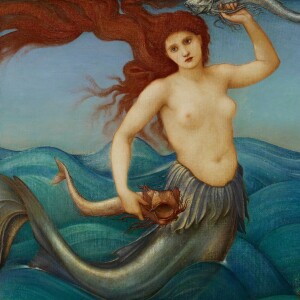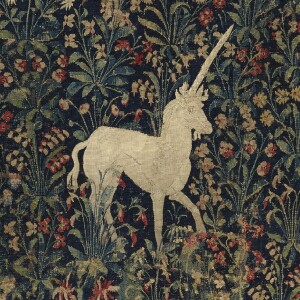Episodes

Monday May 10, 2021
Monday May 10, 2021
When Frida Kahlo dies, in 1954, she is soon forgotten. And then, suddenly, she seems to be everywhere: on magnets, puzzles, underwear, flip-flops. How did this remarkable artist become an international icon, an emoji, a figure of fervid devotion? And what does she mean to those who believe?
You can see Yasumasa Morimura's "An Inner Dialogue with Frida Kahlo," mentioned in the show, in the collection of the Minneapolis Institute of Art: https://collections.artsmia.org/art/109149/an-inner-dialogue-with-frida-kahlo-morimura-yasumasa
Have you heard Frida Kahlo talk? Neither has anyone else--not since she died, in 1954. Unless it turns out that this is actually her, on a recording surfaced a couple years ago by the National Sound Library of Mexico: https://www.youtube.com/watch?v=HjTA2Dd8U9o

Monday Apr 12, 2021
Monday Apr 12, 2021
They are illusions, no more real than someone being sawed in half onstage. Yet the veiled ladies that Raffaelle Monti sculpts in the 1800s are very real to him. Poignant symbols of an identity he’s forced to conceal, even as they make him famous. To launch Season 3, it’s a story of pride and prejudice and dreams just out of reach.
Here you can see Monti’s Veiled Lady, c. 1860, in the collection of the Minneapolis Institute of Art: https://collections.artsmia.org/art/12092/veiled-lady-raffaelo-monti

Monday Feb 08, 2021
Monday Feb 08, 2021
When the young Italian artist Amedeo Modigliani moves to Paris, in the early 1900s, he soon meets a very talented (and very married) Russian poet. What happens when art and love come together, as the rest of the world is falling apart?
You can see one of Modigliani’s iconic Head sculptures here, from the collection of the Minneapolis Institute of Art: https://collections.artsmia.org/art/1502/head-amedeo-modigliani
(Spoiler alert) You can see a close-up of the secret fossil discussed on the show here: https://new.artsmia.org/stories/art-secrets-the-starfish-in-her-face/

Thursday Dec 31, 2020
Thursday Dec 31, 2020
As the page finally turns on 2020, enjoy this bonus episode on the New Year's illustrations made by Winslow Homer for Harper's Weekly magazine in 1869. At a moment surprisingly similar to our own, the American artist captured something of the feeling then, even as his life--and art history--was about to change forever.
You can see the illustrations in the collection of the Minneapolis Institute of Art here: https://collections.artsmia.org/search/new%20year's%20homer

Monday Nov 30, 2020
Monday Nov 30, 2020
Mermaids had been surfacing in art for thousands of years when, in the 1880s, Edward Burne-Jones began painting them as avatars of a radical new female identity in the corseted Victorian era. A story of desire and danger as legendary as the creatures themselves.
You can see one of Burne-Jones' early mermaid paintings, "A Sea-Nymph," at the Minneapolis Institute of Art: https://collections.artsmia.org/art/99878/a-sea-nymph-edward-coley-burne-jones. His best-known mermaid work, "The Depths of the Sea," is at the Fogg Museum at Harvard University: https://harvardartmuseums.org/art/298102
Special thanks to Grace Nuth and Sarah Peverley for sharing their expertise on this episode.
Grace Nuth is a writer, artist, and fine-art model living in central Ohio. She is the senior editor of Enchanted Living magazine and the co-author of The Faerie Handbook. She regularly writes on a variety of topics at her blog at www.gracenuth.com.
Sarah Peverley is a professor of English at the University of Liverpool and a BBC New Generation Thinker. She is writing a cultural history of mermaids, and is the author of several radio programmes, media features, and podcasts about merfolk. You can follow her work at her website (www.sarahpeverley.com), on Twitter at https://twitter.com/Sarah_Peverley, and on Instagram at https://www.instagram.com/sarahpeverley/.

Monday Oct 26, 2020
Monday Oct 26, 2020
Artists have captured unicorns for thousands of years, and for most of that time people thought they were both magical and real. What can an imaginary creature tell us about ourselves? What did we lose when we stopped believing? And why do we still love them anyway?
You can see unicorns in art through the ages in the collection of the Minneapolis Institute of Art, including this tapestry from the late Middle Ages: https://collections.artsmia.org/art/531/allegorical-millefleurs-tapestry-with-animals-belgium
Thanks to Natalie Lawrence and Marguerite Ragnow for sharing their expertise on this episode.
Lawrence is a freelance writer with a PhD from the University of Cambridge on exotic monsters in early modern Europe. She is currently writing a book on the history of monsters. Find her work on her blog (https://themanticore.wordpress.com) and her website (https://www.nataliejlawrence.com).
Ragnow is a historian and curator of the James Ford Bell Library (https://www.lib.umn.edu/bell) at the University of Minnesota, a collection about trade and exploration, featuring rare books, maps, and manuscripts. She is working on a book about unicorns.

Monday Sep 21, 2020
Monday Sep 21, 2020
From narwhals to nautilus shells, dragon eggs to mermaid hands, the obsession with oddities in the Age of Discovery may seem, well, odd. But did the study of outliers, in the early version of museums, help make us the rational creatures we are today?
See the nautilus shell cup from this episode here: https://collections.artsmia.org/art/111675/nautilus-shell-cup-germany

Monday Aug 17, 2020
Monday Aug 17, 2020
The animalier artists love lions and tigers and bears — anything with teeth and no business being in Paris in the 1800s. No one more than Rosa Bonheur, the smoking, joking, pants-wearing painter who becomes a celebrity, the most famous female artist of her time, by embracing the very things men fear most.
You can see one of her lion prints here: https://collections.artsmia.org/art/10491/royalty-at-home-rosa-bonheur
And her painter's palette, charmingly adorned with a deer: https://collections.artsmia.org/art/4483/palette-rosa-bonheur

Monday Jul 20, 2020
Monday Jul 20, 2020
A mysterious stone sculpture, supposedly found in Mexico, is hailed as a Chac Mool, the iconic Mayan vessel of human sacrifice. It tours Europe as a masterpiece of ancient Mesoamerican art. It's featured in magazines and books. But a surprising discovery suddenly begs the question: What is it really?
See the Chac Mool for yourself here: https://collections.artsmia.org/art/17203/chacmool-maya

Monday Jun 15, 2020
Monday Jun 15, 2020
Simeon Solomon is a young art star in the Victorian era. But when scandal threatens his career, offering a cautionary tale to men like Oscar Wilde, he must choose between his livelihood and his identity.
Incredibly, Mia has two works by Solomon in its collection, acquired in the 1960s when Solomon had been all but erased from art history. You can see them here: https://collections.artsmia.org/search/Simeon%20Solomon
